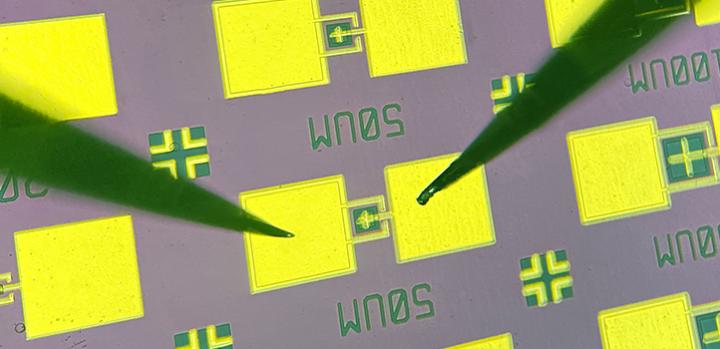Shifting from blue to red for better micro-LEDs

KAUST team works on improving the efficiency of red micro-LEDs
A new micro-LED developed at KAUST (King Abdullah University of Science and Technology) can efficiently emit pure red light and may help in the quest to develop full-colour displays based on just a single semiconductor.
Full-colour micro-displays can be created by combining red, green and blue (RGB) micro-LEDs. Now, a KAUST team of Zhe Zhuang, Daisuke Iida and Kazuhiro Ohkawa have worked to develop a more efficient red LED.
The emission colour of an LED is determined by the material properties of the semiconductor. For example, nitride semiconductors can be used to make blue and green micro-LEDs, whereas phosphide semiconductors are used for red light. But combining different semiconductors in this way makes construction of RGB micro-LEDs more difficult and expensive. Besides, the efficiency of phosphide micro-LEDs reduces significantly with shrinking chip size.
Red-light emitting InGaN can be created by increasing the materials' indium content. But this tends to lower the efficiency of the resulting LED because there is a mismatch between the separation of atoms in the GaN and InGaN, which causes atomic-level imperfections. Moreover, damage to the sidewalls of an InGaN micro-LED induced during the fabrication process makes the new device less efficient. "But we have a chemical treatment to remove the damage and retain the high crystal quality of the InGaN and GaN sidewall interface," explains Zhuang.
Zhang's team created and characterised a series of square devices with a side-length of 98 or 47 micrometers. Their 47-micrometer-long devices emitting light at a peak wavelength of 626 nanometers were shown to have an external quantum efficiency -- the number of photons emitted from the LED per electron injected into the device -- of up to around 0.87 percent. Also, the colour purity of the red micro-LED is optimum because it is very close to the primary red colour defined by the industrial standard known as Rec. 2020.
"The next step is to increase the efficiency of the red micro-LED with even smaller chip sizes, maybe below 20 micrometers," says Zhuang. "Then we hope to integrate RGB nitride-based LEDs for full-colour displays."
'Investigation of InGaN-based red/green micro-light-emitting diodes' by Zhe Zhuang et al; Optics Letters Vol. 46, Issue 8 (2021)


































